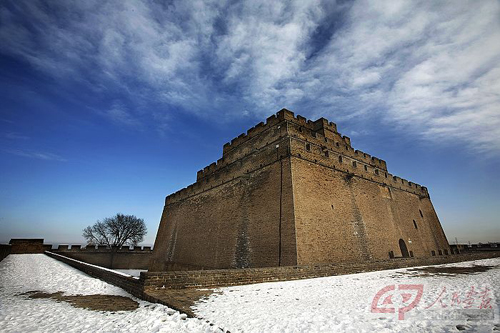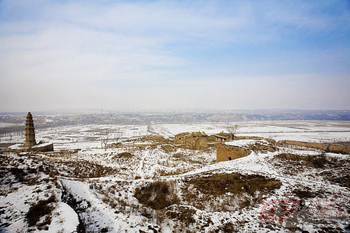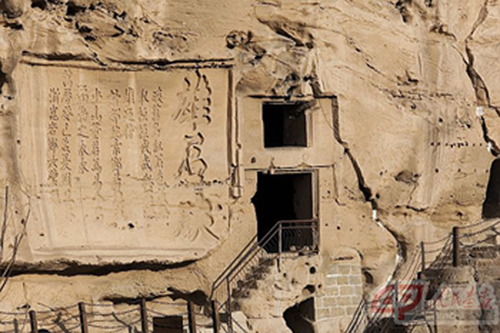Mid-Way through the Great Wall
Historic relics are scattered everywhere along the Great Wall that stretches 8,851.8 kilometers eastward from Jiayu Pass to Shanhai Pass. Commonly considered the two ends of the Wall, the passes are likely the most impressive parts of the world-famous architectural wonder. Though considerably less known, the Zhenbei (literally meaning "Pacify the North") Tower in the middle section of the Wall is another notable architectural marvel that is often overlooked.
|
The Zhenbei Tower, the biggest watchtower on the Great Wall of the Ming Dynasty.[Photo by Huang Dong] |
Atop Hongshan Mountain, four kilometers north of Yulin City in Shaanxi Province, the Zhenbei Tower is known as the biggest watchtower along the Ming Dynasty (1368-1644) section of the Great Wall. Historically, it served military fortification efforts at a strategically important point.
Built in 1607, the Zhenbei Tower originally served as an observation post. The cubic tower has four levels and measures more than 30 meters in height. The north side of its foundation extends 82 meters, the south side 76 meters, and both the east and west sides measure 64 meters, with a total area of 5,056 square meters. The entire tower is laid with black bricks, and each level is surrounded by two-meter-tall battlements, which feature holes for observation. The four levels are connected by stone stairways, and the first level is embraced by well-preserved barracks from ancient times.
Atop the tower, one can view beacon towers, earth mounds, and a collapsed earth-rammed wall snaking into the distance. Historically, Yulin witnessed countless battles between central regimes and nomadic tribes from the North. Consecutive pieces of the Great Wall constructed during the Wei and Qin states and Sui (581-618) and Ming dynasties twist through the area.
Prior to conquering the other six states, Ying Zheng, who later became the first emperor of the Qin Dynasty (221-206 B.C.), ordered construction of the Great Wall in Yulin, sections of which have slept for ages under sand dunes. During an archeological excavation years ago, a 3,000-meter-long piece of the Qin Dynasty Great Wall was discovered. The Great Wall of the Sui Dynasty is largely based on that of the Qin, followed by the Ming. Constructed as military fortifications, the Walls coil along a similar route, regardless of their originating dynasty.
The remains of the earth-rammed Great Wall from the Ming Dynasty are found in northeast Hengshan County. Though some sections have been destroyed, cave dwellings were constructed near some of the remaining walls, and one can sense the magnificence of the past. The section from Yulin to Shenmu is best-preserved, along with stone knives, bowls, swords and plows, and various pottery pieces which were unearthed in the area.
|
The ancient town of Boluo, a historical fortress along the Great Wall of the Ming Dynasty, lies 23 kilometers northeast of the county seat of today's Hengshan.[Photo by Huang Dong] |
Aside from the remains of the Great Wall, there are other historic relics worth visiting, such as the site of Tongwan City, the capital of the Daxia Kingdom (407-431), founded by Hun ruler Helian Bobo during the Period of Sixteen Kingdoms (304-439). First built in 413, the ninth year of the Yixi reign of the Eastern Jin Dynasty (317-420), Tongwan City lies in today's Baichengze Village, Hongdunjie Town in Yulin's Jingbian County, and remains intact as an ancient capital built by a Northern China ethnic minority. Tongwan City is completely rammed with earth. The original layout is preserved, comprised of an outer city and two inner cities: one in the east and the other in the west. From the remains, visitors can still recognize the city walls, gates, turrets, and a moat in the northwest corner with a water channel inside. A number of historic relics from the Han Dynasty (202 B.C.- A.D. 220) through the Song Dynasty were unearthed there, including bronze seals, bronze Buddha statues, bronze mirrors, coins, stone steles, porcelain, and pottery.
|
The site of Tongwan City, the ancient capital of the Hun Kingdom, dating back more than 1,600 years.[Photo by Huang Dong] |
Additionally, cliff carvings are found in the Hongshi Gorge, four kilometers north of downtown Yulin. The gorge boasts a picturesque landscape, and in past dynasties, locals cut grottoes and built temples on which inscriptions are left by men of letters. People opened canals through the mountain for water. The gorge is divided into the north and south sections. Originally, the south section had 44 grottoes housing stone and clay statues, relief carvings, stone steles and Ming Dynasty inscriptions. Presently, only 33 grottoes remain, mostly in the east cliff.
|
The Hongshi Gorge preserves 33 grottoes with stone carvings.[Photo by Huang Dong] |
 0
0 












Go to Forum >>0 Comments